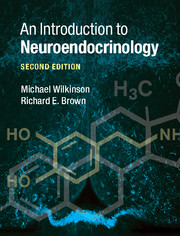Book contents
- Frontmatter
- Dedication
- Contents
- Preface to the second edition
- Acknowledgements
- List of abbreviations
- 1 Classification of chemical messengers
- 2 The endocrine glands and their hormones
- 3 The pituitary gland and its hormones
- 4 The hypothalamic hormones
- 5 Neurotransmitters
- 6 Neurotransmitter and neuropeptide control of hypothalamic, pituitary and other hormones
- 7 Regulation of hormone synthesis, storage, release, transport and deactivation
- 8 Regulation of hormone levels in the bloodstream
- 9 Steroid and thyroid hormone receptors
- 10 Receptors for peptide hormones, neuropeptides and neurotransmitters
- 11 Neuropeptides I: classification, synthesis and co-localization with classical neurotransmitters
- 12 Neuropeptides II: function
- 13 Cytokines and the interaction between the neuroendocrine and immune systems
- 14 Methods for the study of behavioral neuroendocrinology
- 15 An overview of behavioral neuroendocrinology: present, past and future
- Index
- References
9 - Steroid and thyroid hormone receptors
Published online by Cambridge University Press: 05 June 2015
- Frontmatter
- Dedication
- Contents
- Preface to the second edition
- Acknowledgements
- List of abbreviations
- 1 Classification of chemical messengers
- 2 The endocrine glands and their hormones
- 3 The pituitary gland and its hormones
- 4 The hypothalamic hormones
- 5 Neurotransmitters
- 6 Neurotransmitter and neuropeptide control of hypothalamic, pituitary and other hormones
- 7 Regulation of hormone synthesis, storage, release, transport and deactivation
- 8 Regulation of hormone levels in the bloodstream
- 9 Steroid and thyroid hormone receptors
- 10 Receptors for peptide hormones, neuropeptides and neurotransmitters
- 11 Neuropeptides I: classification, synthesis and co-localization with classical neurotransmitters
- 12 Neuropeptides II: function
- 13 Cytokines and the interaction between the neuroendocrine and immune systems
- 14 Methods for the study of behavioral neuroendocrinology
- 15 An overview of behavioral neuroendocrinology: present, past and future
- Index
- References
Summary
In previous chapters, we focused on the neuroendocrine system in terms of a variety of hypothalamic neurotransmitter and hormonal messengers. In Chapter 1, these messengers were seen to act via endocrine, paracrine, autocrine, intracrine and neuroendocrine mechanisms. So far, however, we have not discussed in detail how target cells detect and respond to such messages. Chapter 5 introduced this story by illustrating how neurotransmitters, neurohormones and peptide hormones affect their target cells through receptors localized to the cell membrane. Examples of these receptors are illustrated in Figures 5.2 (ion channel; GABA receptor) and 5.13 (G-protein-coupled receptor) and this type of receptor will be covered in more detail in Chapter 10. The location of receptors on the outside of cells, that is, in the cell membrane, is important for at least two reasons: (1) because peptide hormones are large, water soluble (hydrophilic) molecules which cannot easily pass through the cell membrane; and (2) because cells such as neurons must respond very quickly (seconds) to neurotransmitters like GABA or glutamate that do not have to enter the cell. In marked contrast, steroid hormones (testosterone, estradiol, progesterone, glucocorticoids and mineralocorticoids; Figure 7.3), and thyroid hormones, are small lipophilic (fat soluble) molecules that can readily diffuse through the cell membranes into any cell in the body. As we shall see in this chapter, target cells for steroid and thyroid hormones have receptors that are located inside the cell. These cells therefore respond relatively slowly (minutes to hours) to hormonal stimulation (see Figure 9.1). In brief, the steroid hormone is transported in the blood and released from a binding globulin before freely moving through the cell membrane. Unoccupied steroid hormone receptors (R) are coupled to a molecular chaperone (HSP90; heat shock protein 90) that stabilizes R in the correct shape. When the hormone binds to the receptor-HSP complex, the HSP dissociates and the remaining steroid hormone-receptor complex dimerizes before it enters the cell nucleus. The steroid-R dimer complex then binds to responsive genes via specific hormone response elements (HRE).
- Type
- Chapter
- Information
- An Introduction to Neuroendocrinology , pp. 192 - 235Publisher: Cambridge University PressPrint publication year: 2015



